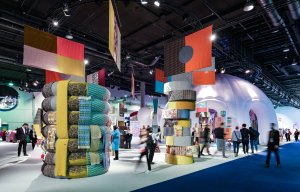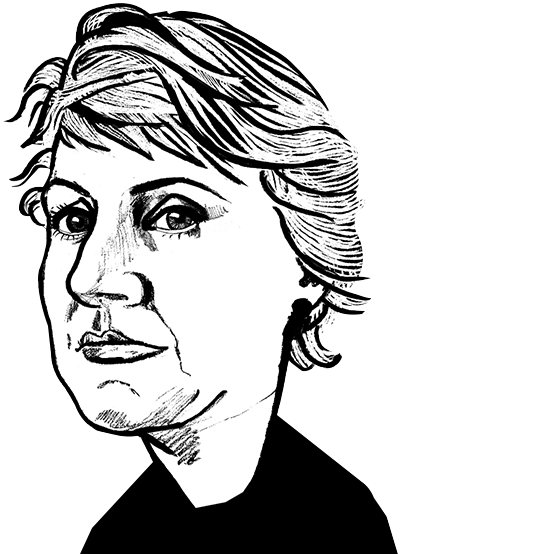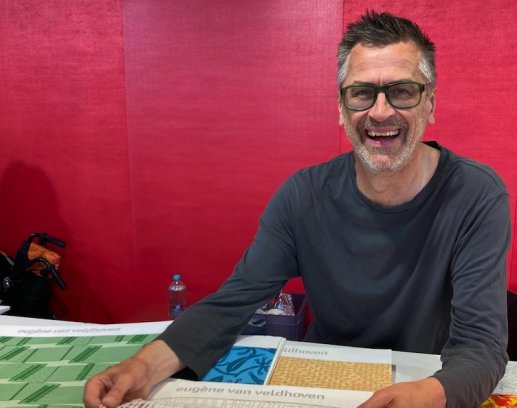
One-time summer edition for Heimtextil
Opinion


Three key strands ran alongside one another, with sustainability, health and wellness frequently intertwined, making the show easy for visitors to navigate.

14th July 2022
Marie O'Mahony
|
Frankfurt, Germany
Heimtextil made a welcome return to the calendar this year at Messe Frankfurt, running from 21st - 24th June. The decision was taken because of the cancellation of the regular Heimtextil in January due to the pandemic. This show is anticipated to be a one-time Summer Special parallel to Techtextil and Texprocess with a return to the usual January schedule in 2023.

Designers showcased collections that combined strong visual and haptic aesthetics, bringing technology and hand techniques with ease and sophistication. Alongside this were brands focused on sustainability as well as the pandemic-propelled consumer demand for wellness and health with sleep at the forefront of a number of innovative developments. The three key strands ran alongside one another with sustainability, health and wellness frequently intertwined making the show easy for visitors to navigate.


Dutch designers had a strong presence with Eugene van Veldhoven and Héléne Dashorst in particular with print and woven textiles respectively. Most eye-catching amongst van Veldhoven’s designs were his exploration of 3D printing techniques using PLA to produce fabrics that were both print and structure. 3D printing geometric red pattern onto a woven wool blend the result is a design offering visual and tactile contrasts. Employed as a structure, it offered a delicate but physically strong lace-like quality.
During the pandemic van Veldhoven had a customised 3D printer built that allows him to print stretch materials. The designer insists that although he began to explore the potential of 3D printing in 2016, he feels to be just at the start of this body of work with an eye to biomaterials next - so this is certainly one to watch.
Héléne Dashorst presented weave designs that were strongly tactile achieved through the selection of yarn as well surface treatments to the woven material. “I go from 100% polyester to 100% cashmere – and everything in between,” the designer told me. Particularly striking was her use of polyurethane-coated yarn to produce fabric in white that served to highlight the weave quality that was subtle yet eye-catching.
Elsewhere, polyurethane and rayon yarns are combined so that when foils are applied to the woven fabric and heat-treated, the rayon portion does not take remaining a blue yarn alongside the pink of the foil-coated polyurethane yarn.

The French design studio Inkfabrik displayed an array of exquisite photogram floral designs for textile as well as wallpaper. Although large-scale, they had a delicate quality and lightness of touch using ferns, wildflowers and other plants produced in an indigo colour. The photograms are by their nature unique, but the resulting designs have often been hand-painted then digitized altering scale, colour and developed as repeat patterns. For textiles, these have then been silk-screen printed onto silk, linen and cotton for dramatic and luxurious effect.

Sustainability was addressed by a great many exhibitors, with approaches that ranged from energy use to recycling, water conservation and the establishment of transparent supply chains. The Spanish manufacturer, Francisco Jover S.A. generates 99% of their energy needs from the photovoltaic system on their rooftops for example, in addition to recycling 100% of their plastic, paper and cardboard waste.
Lech Fabrics introduced high-quality PET fibres that look to use plastics from other industries that would otherwise end up in landfill forests and oceans. The company are investing in innovation and expanding their portfolio of such products. In the process, the company says it saves 94% water, 60% energy and 32% CO2 emissions in the production of its fibres from PET when compared to new production.
The Austrian Lenzing Group is following the path of a holistic approach that encompasses the circular economy and renewable materials. As a producer of wood-based pulps and fibres, Lenzing is at the beginning of the value chain for the production of textiles and nonwoven products. Central to this is an intensive cooperation across the entire value chain with the traceability of raw materials within the value chain seen as key.
Fiber Partner were offering a Primaloft Bio, a biodegradable synthetic fibre that uses a hydro-degradation process. Their approach to circularity is to consider the degradation process in landfill as well as the marine/ocean environment. In the landfill environment 93.7% biodegradation occurs within 646 days under ASTM D5511 conditions, while 86.1% is achieved within 1,563 days under ASTM D6691 conditions in the marine/ ocean environment.
The company sources both virgin and recycled materials from a controlled supply chain offering the same performance and characteristics including level of whiteness as conventional PET. Fiber Partner stress that the fibres do not biodegrade during their use and at the end of life the fibres can be chemically recycled. The technology has achieved both Global Recycled Standard and Oeko-Tex Standard 100 approvals.

The Heimtextil Conference ‘Sleep & More’ focused on the mega-topic of sleep and the sustainable hotel industry, with additional lectures and guided tours as part of Interior.Architecture.Hospitality. The theme was supported by the number of exhibitors with collections on the same theme.
Stress reduction and sleep enhancement featured across a number of textiles, aimed at bedding applications in particular. Devan were keen to emphasise their environmental credentials in this market using a vegan wax in the Phase Change Materials (PCMs) for bio-cooling for example. They are also using Pulcra Tec SU, a bio-based hydrophobic agent that is fluorine-free. CBD, valerian and camomile are all utilised by the company to offer relaxation and help to induce a better night’s sleep. The Devan products span thermoregulation, comfort, health and wellness, odour control and protection.
Messe Frankfurt have reported around 2,200 international exhibitors registered for Heimtextil 2023. This is around 75% compared to Heimtextil 2020. The next Heimtextil will take place from January 10 to 13, 2023.

Business intelligence for the fibre, textiles and apparel industries: technologies, innovations, markets, investments, trade policy, sourcing, strategy...
Find out more